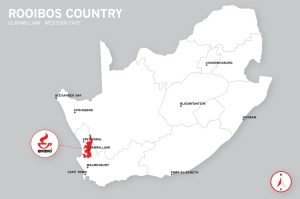
Have you ever heard of rooibos ? Have you ever tasted rooibos tea? Well, as it is named, rooibos stands for red bush in Afrikaans, as denoted by its color. It is very popular in Southern Africa and has been consumed for centuries by the local indigenous Sān and Khoi people. It grows exclusively in South Africa, in the Cederberg mountains north of the city of Cape Town. The leaves are used in a herbal tea, whose color is red like that of hibiscus tea. Traditionally, the local Sān people would climb the mountains and cut the fine, needle-like leaves from wild rooibos plants. They then rolled the bunches of leaves and brought them down the steep slopes using donkeys. The leaves were then chopped with axes and bruised with hammers, before being left to dry in the sun. Later on, once the European settlers had taken over the trade, no recognition to the indigenous people knowledge and input was given… until last week! Check out excerpts from the article published on South Africa’s Mail and Guardian below, and do not forget to follow the link for the full article.
=====

Transformation in the rooibos sector has been slow. The genocide of the indigenous San people and the virtual enslavement of the Khoi people in rooibos-growing landscapes of the Cape centuries ago, coupled with a government-controlled monopoly during the apartheid years, has led to a highly skewed and fractured industry.
Today, this R300-million local enterprise remains in the hands of about 300 white commercial farmers who cultivate 93% of the planted area. About 200 small-scale coloured farmers — largely confined to the dryer, more marginal parts of the winter rainfall fynbos region — produce only 2% of all rooibos tea.
A benefit-sharing agreement announced today by the minister of environmental affairs — between the rooibos industry and representatives of San and Khoi organisations — could signal the beginning of a change.
More than R10-million a year — depending on weather, volumes and the price of rooibos — is likely to be distributed to trusts set up by San and Khoi organisations.

If implemented judiciously and strategically, this could well change the face of rooibos in South Africa.
[…] At the agreement’s core is an annual traditional knowledge levy of 1.5% of the price that is paid by processors to farmers per kilogram of harvested rooibos. After being deposited into the government’s bioprospecting trust fund, the levy will be paid in equal parts to the San Council and National KhoiSan Council. “Rooibos indigenous farming communities” — defined as “rural farming communities in rooibos growing areas who consist of descendants of original Khoi-Khoi peoples” — are to receive a portion from the trust set up for the Khoi people although the exact proportion has not yet been determined.
Non-monetary benefits will also be “explored” and could include the creation of employment opportunities, bursaries, development schemes, mentoring and the facilitation of livelihoods.

The agreement is a landmark, not only because it acknowledges the indisputable contribution made by traditional knowledge holders towards the establishment of the industry, but also because it could bring significant material benefits to indigenous San and Khoi people, many of whom remain marginalised and poverty stricken.
That the agreement offers restorative justice is undeniable, but the road ahead is far from smooth. Questions of how exactly benefits will be shared at a local level remain unresolved, and could result in conflicts. The long and troubled history of these oppressed communities has included dislocation, fracturing of family and community structures, and the undermining of people’s own initiatives.
The presence of strong, effective and transparent governance structures and sound external support will be essential to manage conflicting priorities proactively and ethically so that real benefits can be derived by all of the intended beneficiaries. …


I was totally unaware about the history or origins of Rooibos tea. It’s stories like these that prove how there needs to be more fair trade products and restorative justice.
LikeLike
Yes… there needs to be more fair trade products overall. There are so many people sweating and harvesting products out there, and yet getting less than pennies. And this is a real fight!
LikeLiked by 1 person
I definitely degree. Watching the Black Gold documentary when I was a teenager was an eye-opening experience. That was about the coffee industry, but it applies to so many fields.
LikeLike
Yes…
LikeLiked by 1 person